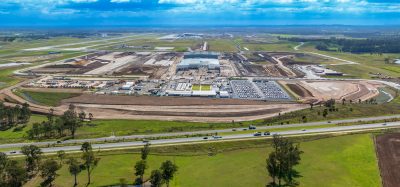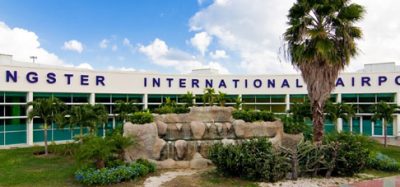A 21st century update for Chicago
- Like
- Digg
- Del
- Tumblr
- VKontakte
- Buffer
- Love This
- Odnoklassniki
- Meneame
- Blogger
- Amazon
- Yahoo Mail
- Gmail
- AOL
- Newsvine
- HackerNews
- Evernote
- MySpace
- Mail.ru
- Viadeo
- Line
- Comments
- Yummly
- SMS
- Viber
- Telegram
- Subscribe
- Skype
- Facebook Messenger
- Kakao
- LiveJournal
- Yammer
- Edgar
- Fintel
- Mix
- Instapaper
- Copy Link
Posted: 16 September 2005 | Roderick R. Drew, O’Hare Modernisation Project Spokesperson | No comments yet
After an exceptionally lengthy development phase, the controversial plans to expand Chicago O’Hare will finally become reality later this year.
After an exceptionally lengthy development phase, the controversial plans to expand Chicago O’Hare will finally become reality later this year.
The concept of modernising O’Hare International Airport has been debated in the Chicago region for more than three decades now. Currently, the City of Chicago is preparing to move forward with the O’Hare Modernization Programme. Mayor Richard M. Daley’s solution to the problem of delays and congestion at O’Hare can be described as the most anticipated airport improvement project in the world.
O’Hare is a vital hub in our nation’s transportation system. In 2004 O’Hare set an all-time record for flight operations with more than 992,000 flights and once again held the title of the world’s busiest airport. However, the world’s busiest airport is also known as the nation’s most delayed airport.
Following the summer of 2000, when O’Hare passengers experienced intolerable delays, the United States Congress held hearings on the issue of flight delays. At those hearings, Congress mandated local leaders to come up with a solution – or risk government intervention. In response, Mayor Richard M. Daley announced the concept of the O’Hare Modernisation Programme (OMP) in June 2001, a bold plan to reconfigure O’Hare’s outdated intersecting runway system into a modern, parallel runway configuration, substantially reducing delays and increasing capacity well into the future.
Components and benefits
The O’Hare Modernisation Programme is a USD 6.6 billion programme, when stated in 2001 dollars. The programme consists of:
- The construction of one new runway, the relocation of three existing runways and the extension of two other runways.
- A new terminal and related facilities on the west side of the airport, to accommodate up to 60 new gates. A new entrance on the west side of O’Hare.
- An Automated People Mover System.
- Wetlands mitigation and land acquisition.
- On Airport access roads.
The potential benefits of the O’Hare Modernisation Programme are tremendous: a significant reduction in delays; substantial economic growth to the region’s economy and huge annual savings for both air passengers and the airlines that service O’Hare. These benefits will be realised by modernising the airport. Modernisation involves changing the current configuration to a parallel runway to reduce delays and increase capacity for the future.
The OMP will also create up to 195,000 new jobs, in addition to the 450,000 jobs O’Hare is responsible for today. Further to this it will pump an additional USD 18 billion into the Chicago region’s economy annually, on top of the USD 38 billion it currently generates.
Additionally the OMP will save air passengers and the airlines a combined USD 750 million in reduced delays each year. These savings total nearly USD 8 billion over a ten-year period, reason enough to move the project forward.
Configuration limitations
Delays at O’Hare are currently caused by its intersecting runway configuration. While the airport operates relatively smoothly during good weather, during certain weather conditions air traffic controllers are forced to remove an arrival runway, effectively reducing O’Hare’s arrival capacity by one third and creating delays that affect the entire nation.
The FAA’s own analysis of the OMP shows that by 2018, delays at O’Hare will decrease from today’s average of nearly 18 minutes to less than six minutes per flight. More importantly, O’Hare will experience significantly reduced delays while accommodating a forecasted demand of 1.2 million flights, an increase of more than 200,000 flights annually.
The OMP will be paid for with the revenues generated at the airport. In July 2003, Mayor Daley and O’Hare’s airline partners announced a historic USD 2.9 billion funding agreement for the initial phase of the programme. As part of that deal, 65 per cent of Phase One will be paid for with general airport revenue bonds, which will be backed by airport revenues such as terminal rents, landing fees, parking and concession revenue. 23 per cent will be paid for by passenger facility charges, a USD 4.50 ticket tax for every flight originating from O’Hare. Finally the remaining 12 per cent will be sourced from federal Airport Improvement Programme discretionary and entitlement grants.
OMP Phase One
Once the City receives federal approval, construction will begin on the USD 2.9 billion Phase One. This includes:
- Planning, environmental studies and preliminary engineering for the entire OMP.
- New northern runway 9L/27R.
- Extension of Runway 10L/28R.
- Relocation of Runway 10C/28C.
After this construction will begin on a new terminal complex, which will create a new entrance to the airport for its western neighbours. This new terminal will accommodate up to 60 gates, include a parking facility, a secure automated people mover system, and the opportunity to include two regional commuter train stations. Passengers will finally be able to access O’Hare from the west side of the airport. The secure people-mover system will transport ticketed passengers between terminals regardless of which air carrier they are flying.
The city of Chicago has also worked cooperatively with state and local officials on important regional road improvements that will complement the modernisation. O’Hare will protect a 300 ft corridor on airport property to allow the state to design and build a road connecting two major expressways near O’Hare, as well as the completion of a western expressway to come into the airport.
In August 2005 President George W. Bush signed a federal transportation funding bill that sets aside USD 140 million for preliminary engineering and design of the western expressway into O’Hare, a critical first step in creating ‘western access’ to the airport.
Sustainablility
The O’Hare Modernization Programme is proud to have developed a Sustainable Design Manual as a way to incorporate ‘green’ concepts during construction.
The OMP’s construction emissions reduction plan requires OMP construction equipment to use ultra low sulfur diesel fuel and require either new construction equipment or retrofit of older equipment with an emissions reduction device to improve air quality.
We are recommending that the FAA build a green roof for the base building of the tower, as well as exploring sustainable design initiatives for the building itself. If approved, O’Hare would be among the first airports in the country to incorporate a vegetated roof on a portion of an FAA air traffic control tower facility.
We are working with our project planners and designers in an effort to keep as much dirt on site as possible and reduce construction traffic on local roadways.
We have also designed the canopy atop our relocated Guard Post #1 that will accommodate a 6,400 sq. ft. vegetated roof. The O’Hare Modernization Programme is also replacing 150 acres of low quality wetlands on airport property with more than 400 higher quality passive recreation wetlands throughout the region.
Environmental impact
The FAA issued its Final Environmental Impact Statement (FEIS) in July, the most comprehensive level of review for an airport project. The FEIS analyses the purpose and need of a programme, reasonable alternatives and environmental impacts that could result from the proposed project. Part of the process includes input from other regulatory agencies and from the public.
After weighing several options for action at O’Hare, including No-Action and two alternative airport configurations, the FAA recommended the O’Hare Modernization Programme as its ‘preferred alternative’ for construction at the airport. The FAA initially examined 15 alternatives for reducing delays and increasing capacity at O’Hare and ruled out the use of other airports as a viable solution to meeting the projected airport capacity needs of the region.
Following a minimum 30-day review period, the FAA will issue a Record of Decision on the O’Hare Modernization Programme. We expect to receive that ruling in September 2005. Once the Record of Decision is received, we intend to break ground immediately- and all the delay reductions, capacity enhancements, and economic benefits associated with the OMP will be realised.
While the FAA estimates that demand for service at O’Hare will continue to grow, the airport has reached critical capacity. If we do nothing to modernise the airport, the state of Illinois, the city of Chicago and the region will continue to lose flights and passengers to major metropolitan areas with large hub airports such as Dallas-Ft. Worth, Atlanta and Denver.
Mayor Daley’s bold vision for a 21st century airport will allow O’Hare to satisfy the region’s needs for air travel well into the future and ensure that passengers see an end to the delays and congestion that have plagued O’Hare for decades.


















